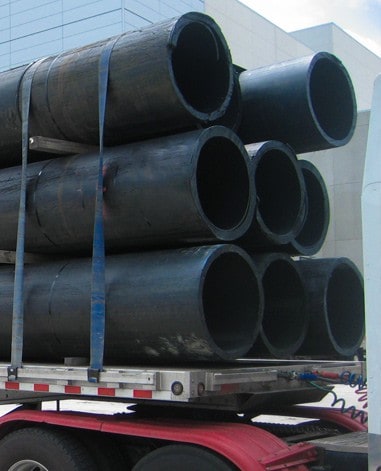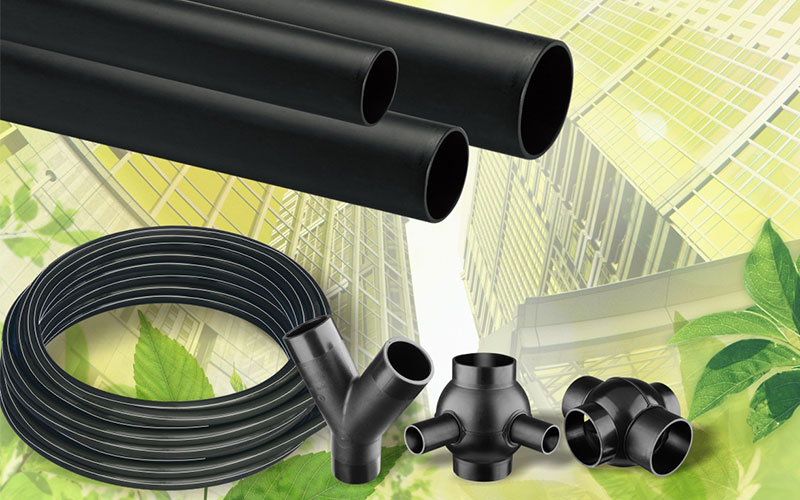Explore the Manufacturing Refine Behind High-Quality HDPE Pipe and Its Applications
The production process of high-quality HDPE pipes is detailed and systematic. It begins with the selection of raw materials that boost efficiency. Following this, ethylene goes through polymerization to create material, which is after that shaped via extrusion. Quality control is paramount, making certain that the end product meets rigorous requirements. The journey of HDPE pipelines doesn't end with production. Their applications throughout various industries expose a more comprehensive value worth examining.
Understanding HDPE: Qualities and Advantages

High-density polyethylene (HDPE) is a flexible polycarbonate understood for its longevity and resistance to different environmental factors. This material shows outstanding tensile stamina, making it appropriate for demanding applications. Its low-density framework contributes to a light-weight product, helping with ease of handling and installment. HDPE likewise showcases remarkable resistance to chemicals, which minimizes degradation when subjected to severe substances.
The product's reduced wetness absorption further enhances its long life, making it ideal for use in pipelines and tank. Additionally, HDPE is resistant to ultraviolet (UV) radiation, making certain that items preserve their honesty also when subjected to sunshine. Its adaptability permits for the development of detailed forms without endangering toughness. The environmentally friendly nature of HDPE, often acquired from recycled materials, adds to its appeal, promoting sustainable methods in production. On the whole, these homes and benefits make HDPE a preferred selection for numerous industrial and consumer applications.
Resources Choice for HDPE Manufacturing
The choice of basic materials for HDPE manufacturing is necessary to confirm the end product meets the desired specs and high quality standards. High-density polyethylene (HDPE) is mostly produced from polymerized ethylene, originated from fossil fuels such as gas or unrefined oil. The quality of these feedstocks greatly affects the mechanical and thermal residential properties of the final HDPE.
Ingredients also play a substantial role in improving HDPE's performance, consisting of anti-oxidants, UV stabilizers, and colorants, which enhance longevity and resistance to environmental aspects. The option procedure should think about not only the chemical make-up of the raw materials yet additionally their processing characteristics to guarantee efficient manufacturing.
The sourcing of raw products should prioritize sustainability and compliance with environmental regulations, as accountable techniques are important in today's market. Ultimately, cautious basic material choice lays the foundation for creating top quality HDPE pipes suitable for varied applications.
The Extrusion Refine: Shaping HDPE Pipeline
The extrusion process plays a crucial function fit HDPE pipelines, beginning with thorough material prep work strategies that ensure suitable flow and uniformity. Similarly crucial is the style of the die, which straight influences the last measurements and surface high quality of the pipe. With each other, these elements add significantly to the efficiency and top quality of HDPE pipeline production.
Product Preparation Methods
Efficient production of HDPE pipes starts with precise material preparation techniques, particularly the extrusion process. During this stage, high-density polyethylene material is very first dried out to remove wetness, guaranteeing optimal circulation characteristics. The resin is after that fed into the extruder, where it goes through heating and melting, changing into a thick state. This home heating procedure is thoroughly regulated to keep the product's honesty and efficiency. The molten HDPE is forced through a die, shaping it right into a continuous pipe form. Proper temperature level monitoring throughout extrusion is necessary, as it straight impacts the product's buildings and the last product high quality. When shaped, the HDPE pipe is cooled and reduced to specified lengths, ready for succeeding handling and applications.
Die Design Relevance
Accuracy in die layout plays a vital role in the extrusion process of HDPE pipelines. The die acts as the last shaping device, directly affecting the pipe's dimensions, wall density, and surface coating. A well-designed die warranties consistent material flow, reducing issues such as irregularities and weak areas. The geometry of the die should be optimized to suit the specific residential or commercial properties of HDPE, including its thickness and thermal actions throughout extrusion. In addition, the cooling price of the material as it goes through the die can significantly affect the pipeline's structural honesty. Investing in sophisticated die technology is important for manufacturers aiming to produce top quality HDPE pipes that satisfy sector standards and consumer assumptions.
Quality Assurance Measures in HDPE Manufacturing
Although numerous aspects influence the top quality of HDPE pipe manufacturing, efficient quality assurance steps are important to guarantee consistency and integrity in the end product. Key quality assurance techniques consist of strenuous product evaluation, verifying that the raw polyethylene meets established standards for pureness and thickness. Throughout the extrusion procedure, specifications such as temperature, pressure, and cooling time are closely kept an eye on to maintain dimensional precision and architectural honesty
Furthermore, post-production testing is essential; makers frequently conduct hydrostatic examinations to assess the pipe's toughness and resistance to stress. Aesthetic inspections for surface issues additionally enhance quality control. Qualification from appropriate standards companies, like ASTM or ISO, gives an added layer of credibility. By executing these complete top quality control measures, makers can reduce problems, enhance efficiency, and make sure that the HDPE pipes satisfy the particular demands of various applications, inevitably causing consumer satisfaction and depend on in the item.
Applications of HDPE Pipe Across Industries
HDPE pipelines are used across different fields because of their longevity and adaptability. In water circulation systems, they assure efficient distribution, while in wastewater management, they offer reliable remedies for waste transport. Furthermore, agricultural irrigation networks take advantage of HDPE's resistance to deterioration and flexibility, making it an excellent choice for contemporary farming practices.

Water Distribution Equipments
A considerable number of sectors rely upon high-density polyethylene (HDPE) pipes for reliable water distribution systems. Recognized for here their resilience and resistance to corrosion, HDPE pipelines are widely utilized in metropolitan water system networks, farming watering, and industrial applications. Their lightweight nature assists in very easy handling and installation, lowering labor prices and time. Furthermore, HDPE pipelines can suit different stress levels, making them appropriate for both low and high-pressure systems. Texas hdpe pipe manufacturer. The adaptability of the product enables for smooth assimilation right into existing framework, reducing the requirement for substantial excavation. Additionally, HDPE's resistance to chemical leaching guarantees that the water provided remains secure and tidy, making it an excellent choice for maintaining the high quality of safe and clean water throughout numerous markets
Wastewater Management Solutions
Efficient water circulation systems also lead the way for ingenious wastewater monitoring solutions, where high-density polyethylene (HDPE) pipelines play a considerable role. Popular for their longevity and resistance to deterioration, HDPE pipelines are optimal for delivering wastewater in various settings. Their flexibility enables very easy installment in complex settings, reducing the demand for considerable excavation. Furthermore, HDPE's smooth indoor surface lowers friction, improving flow rates and efficiency. These pipelines are also immune to chemical leaching, guaranteeing that impurities do not endanger the surrounding atmosphere. Industries, districts, and treatment facilities increasingly depend on HDPE pipes for their dependability and longevity, making them a recommended selection for modern wastewater administration systems. This versatility emphasizes the essential importance of HDPE pipes across various applications.
Agricultural Watering Networks
Agricultural watering networks profit greatly from the usage of high-density polyethylene (HDPE) pipelines, which supply efficient and reliable water delivery to plants. HDPE pipes are lightweight, making them very easy to move and set up, while their flexibility enables for different arrangements in varied surfaces. These pipes show outstanding resistance to rust, chemicals, and UV radiation, guaranteeing durability in extreme agricultural environments. Additionally, their smooth indoor surface area lessens rubbing loss, optimizing water circulation and minimizing power costs related to pumping. The long life of HDPE pipes, usually going beyond half a century, contributes to reduce upkeep and substitute costs. Farmers increasingly rely on HDPE pipelines to improve watering performance and promote lasting farming practices, inevitably leading to enhanced plant returns and source conservation.

Future Fads in HDPE Pipeline Innovation
As the demand for sustainable and efficient infrastructure expands, advancements in HDPE pipe technology are positioned to transform different industries. Arising trends consist of the integration of wise technologies, such as sensors and IoT abilities, which facilitate real-time surveillance of pipe problems, decreasing upkeep expenses and avoiding leakages. Furthermore, the advancement of innovative production techniques, such as 3D printing, is making it possible for the manufacturing of facility, tailored pipeline styles that provide to details project requirements.
Moreover, the focus on recycling and round economy practices is driving the advancement of HDPE pipes made from recycled materials, enhancing sustainability. Improved jointing methods, such as electro-fusion and mechanical fittings, are likewise boosting setup efficiency and dependability. Finally, the expanding focus on environmental laws is pushing manufacturers to embrace greener production procedures, making sure that HDPE pipes not just fulfill market requirements yet also cultivate an even more sustainable future for framework development.
Often Asked Inquiries
Exactly How Does HDPE Compare to Other Plastic Materials?
HDPE outshines many various other plastic products pertaining to toughness, chemical resistance, and versatility. Its reduced thickness and high tensile stamina make it perfect for numerous applications, commonly surpassing choices in both efficiency and longevity.
What Are the Ecological Effects of HDPE Manufacturing?
The environmental influences of HDPE production include greenhouse gas emissions, power usage, and potential pollution from producing processes. Furthermore, improper disposal can lead to soil and water contamination, increasing problems regarding long-lasting environmental impacts.
Can HDPE Piping Be Reused?
Yes, HDPE pipelines can be reused. Lots of centers approve made use of HDPE for processing, changing it into brand-new products. This reusing adds to sustainability initiatives, lowering plastic waste while conserving resources and power in the manufacturing cycle.
What Is the Life Expectancy of HDPE Pipeline?

Just How Do Temperature Variations Affect HDPE Pipe Performance?
Temperature level variants significantly influence HDPE pipe performance, affecting versatility and toughness. High temperatures can bring about softening, while reduced temperature levels might create brittleness, ultimately influencing the pipeline's resilience and viability for different applications in varied environments.